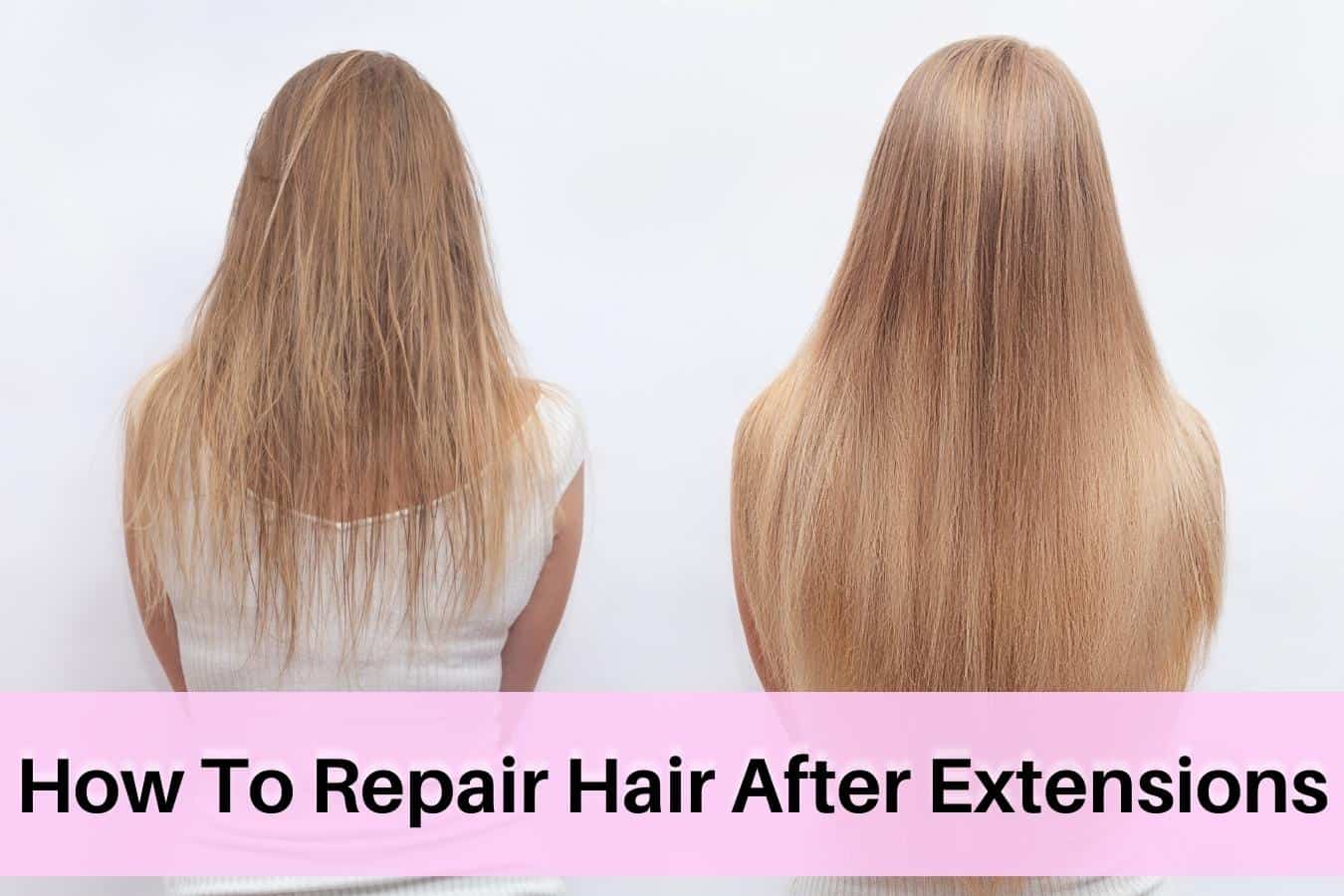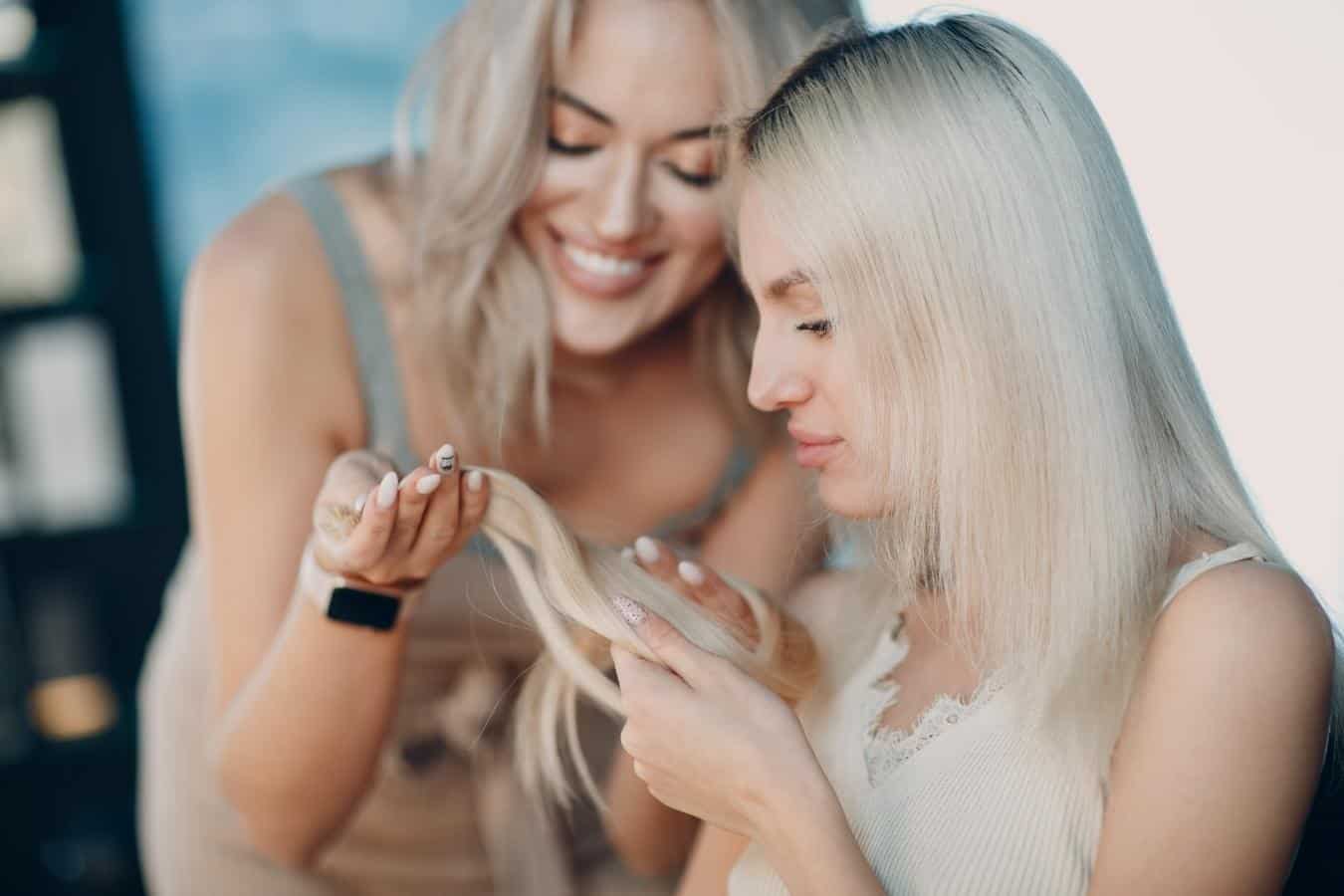Hair extensions can transform a bad hair day into a good one, helping to reduce the look of split ends and hair breakage. However, sometimes hair extensions might cause some damage. In this article, I explain just how to repair your hair after getting extensions.

Do Extensions Damage Your Hair?
As detailed by the American Academy of Dermatology Association, hair extensions can sometimes cause damage to individuals of all hair types and textures.
In the worst instances, extensions may even result in hair loss as a result of extensive damage to the hair follicles.
But why does this happen? Whether you get extensions that clip in or need to be sewed in, they’re going to be pulling on your natural hair and hairline.
It’s the same kind of damage that you’d experience from wearing a tight ponytail or bun in your hair on a daily basis.
This constant pulling will weaken your existing hair, damaging the hair follicle.
The hairline will most likely begin to change as a result of this extended period of tugging, causing traction alopecia.
Worse, when your hair follicles are damaged, this inhibits their ability to enable hair growth.
You’ll therefore likely experience hair loss and shedding, and won’t be able to regrow hair because of this damage.
How To Repair Your Hair After Extensions: 9 Top Tips

1. Strengthen your existing hair
If your hair is strong and elastic, it’s going to be better able to spring back from any potential damage caused by extensions.
To strengthen and restore your hair to its pre-extension health, look to use haircare products that contain proteins like collagen, keratin, biotin, and silk or hydrolyzed wheat proteins.
Your hair is overwhelmingly made up of protein, so it’s important to keep reinforcing this vital building block so that your strands recover their structure and strength.
Many shampoos and conditioners are now fortified with these proteins, so it’s worth researching the best.
Similarly, there are a number of hair masks that are also designed to support and strengthen the protein bonds in your hair.
Olaplex is also one of the best known products for repairing hair damage by restoring broken disulfide bonds in the hair. It will also help to prevent future damage, too.
2. Go for a haircut
This might seem counterintuitive, but you actually might need to go for a haircut in order to repair and restore hair after wearing extensions.
As already detailed, hair extensions can cause damage to your hair through excessive traction – or, pulling and tugging.
This can result in a high number of split ends, as well as dry, brittle hair that’s prone to breakage.
If your hair looks and feels like straw and is full of split ends after wearing extensions, one of the best ways to help it recover is by going for a haircut.
Your stylist will remove all of these split ends and can always add in a boosting treatment such as a protein-rich hair mask if you want to give your hair a little extra treat.
3. Avoid super-hot showers
We know, sometimes on a cold day, there’s just nothing better than a super-hot shower. But showering in excessive heat can damage and dry out both your skin and hair.
The hot water will strip your hair of moisture and its natural oils, breaking down the keratin (protein) bonds in your hair and damaging the cuticle.
Plus, because your hair is dryer, your scalp will then go into overdrive and produce more oil, which may cause further problems down the line.
It’s really best to stick to lukewarm water when showering – particularly if you’re trying to repair and protect the hair after wearing extensions.
4. Treat your scalp
Happy hair begins with a happy scalp, so it’s worth investing time and energy to give it some TLC.
Try massaging oils into your scalp in order to nourish and condition the skin and help with hair growth.
You could try oil like rosemary, which has been linked to hair thickness and growth and may help to reduce any itching sensations if you’re prone to them.
Lavender oil, meanwhile, is both soothing and de-stressing thanks to its delicious aroma but is also antibacterial and antimicrobial.
Tea tree oil may be the best oil with which to treat your scalp. Not only is it antimicrobial and antibacterial, it’s also intensely cleansing, and may help to unplug hair follicles and support hair growth, which is vital after wearing hair extensions.
Massage the oil into your scalp and leave it on for up to twenty minutes or even overnight (you can always tie a silk scarf over your head).
Don’t forget to wash the oil out the next morning so as to reduce greasiness.
You can also invest in a scalp brush if you’re keen to stimulate your hair follicles and promote growth. Use before or whilst you’re shampooing and enjoy the relaxing benefits.
5. Take hair supplements
There are so many supplements now that it may feel overwhelming to find ones that work for you, but the benefits of having so many on the market mean that you are likely to discover one that really works.
When it comes to a supplement to support hair growth and repair after wearing extensions, look for those containing ingredients like biotin – or vitamin B7 – which helps the body to produce keratin, which is the main protein of which hair is made up.
Other ingredients should include vitamin B12 and zinc, which help support the normal functioning of the hair follicle and therefore contribute to hair thickness.
Look for other vitamins including C, E, B1, B2, and B6, and try to keep up your iodine intake, too.
6. Put down the heated styling tools
Sometimes you need to use your curling tongs or flat iron, we get it. But if you’re looking to repair hair after wearing extensions, it’s really best to avoid the use of heated styling tools.
With the best will in the world, these can cause further damage and dehydration to your strands.
If you can’t live without them, then make sure to always apply a heat protection spray before using either curlers or straighteners.
Similarly, use your blow dryer on the coolest setting possible and ensure that you’ve left enough space between your scalp and the tool.
7. Work on your diet
If you’re looking to repair hair after wearing extensions, look to care for your hair from the inside out by improving your diet.
Vitamins and minerals play an important role in supporting and strengthening hair follicles, and you should also ensure you get enough iron, riboflavin, and protein, too.
Some of the best foods to support the restoration of your hair include beans, legumes, lentils, eggs, tofu, spinach, nuts, berries, quinoa, sweet potatoes, and fish.
All of these are great sources of protein and other vitamins for your hair and are worth incorporating into your diet.
8. Establish good sleep habits
By now, the benefits of a good night’s sleep are difficult to argue with. If you’re looking to protect and repair hair after damage from extensions, you need to ensure that you are well-rested.
But it’s also important to ensure that you’re not going to be risking any damage to your fragile hair overnight.
If you can switch your cotton pillowcase out for a silk one, you’ll be helping to reduce any friction caused between your hair and the pillow.
This, therefore, reduces the risk of any tugging or pulling, both of which are a big no for hair that’s recovering from the traction of hair extensions.
9. Protect your hair from UV rays
If your hair is already fragile and prone to breakage after wearing hair extensions, and you’re needing to protect your existing strands and support growth and repair, it’s likely worth investing in UV protection.
The sun’s UV rays aren’t just damaging for your skin – they can also cause problems for your hair, too, dehydrating them. Invest in a UV spray and always apply it to your hair before leaving the house.
Should You Give Your Hair A Break From Extensions?

It’s wise to give your hair a break from regular use of extensions.
Ideally, you’d stick to wearing extensions for a maximum of three months before giving your hair and hairline a break of anywhere from four to eight weeks.
Although you can wear hair extensions back-to-back, we don’t recommend doing so.
Consistent use of hair extensions without any time off risks causing damage to the hair follicle, and you may even experience bald spots on your scalp and along your hairline.
You should also always have your extensions professionally applied and removed, so as to reduce the risk of damage to your hair.
That said, even if you do so, you still may notice some degree of damage, which is a clear indicator that you need to be laying off the extensions for a while to let your hair repair.
Frequently Asked Questions
There’s no one answer to this, as it depends on how badly your hair follicles have been damaged. Your hair follicles are responsible for hair growth, and if they are damaged beyond repair, then you may struggle to grow hair back without medical intervention.
Unfortunately, even if your extensions are professionally applied and removed, you may still experience some hair loss and shedding after wearing them. Extensions can tug and pull on your hairline, causing some hair fall, and may even damage your hair follicles, preventing future growth.
Disclaimer: This site is not intended to provide professional or medical advice. All of the content on LovedByCurls.com is for informational purposes only. All advice should be followed at your own discretion. Ingredients may change at any time so always check the product label before using. Check our full disclaimer policy here.
